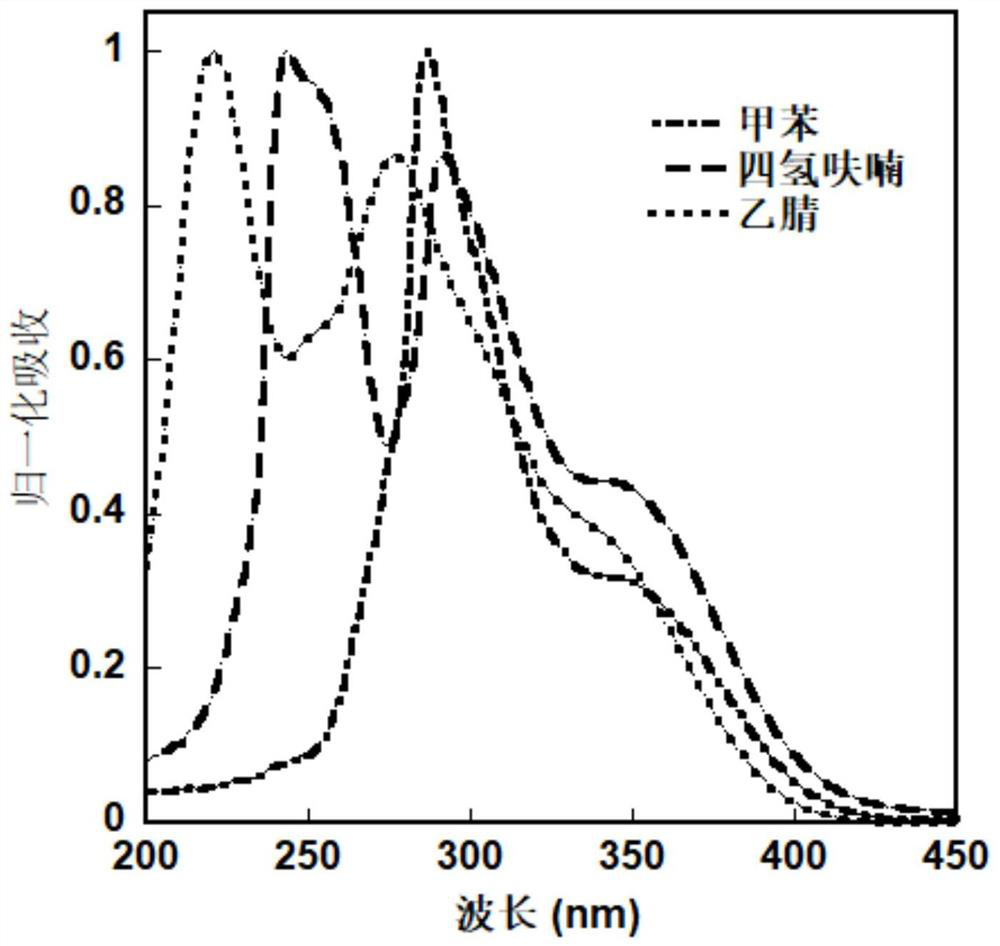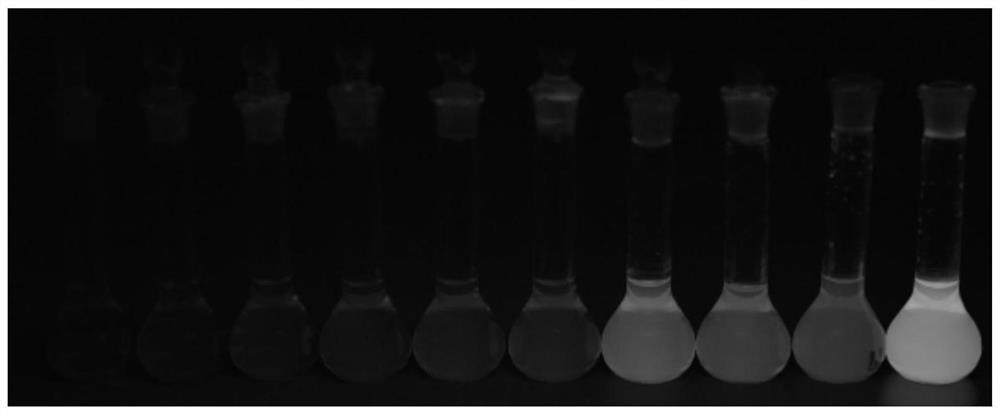Assembled adjustment and control fluorescence enhanced aggregation-induced emission material, micro-nano sphere, preparation method and application
A technology of aggregation-induced luminescence and fluorescence enhancement, applied in the fields of luminescent materials, halogenated hydrocarbon preparation, chemical instruments and methods, etc., can solve the problems of decreased fluorescence efficiency, limited application, etc. simple craftsmanship
- Summary
- Abstract
- Description
- Claims
- Application Information
AI Technical Summary
Problems solved by technology
Method used
Image
Examples
Embodiment 1
[0047] The synthetic route of intermediate compound b:
[0048]
[0049] Synthesis of intermediate compound b
[0050] In a three-necked flask equipped with a magnetic stirrer, add 2 parts of bis(4-bromophenyl) ketone a, 5 parts of potassium acetate, 2.5 parts of bisglutaryl diboron and 0.1 part of Pd(dppf)Cl 2 Dissolve in 100 parts of 1,4-dioxane, stir at 80°C for 16-24 hours, then extract with dichloromethane, wash with saturated brine for 4 times, dry with anhydrous magnesium sulfate, filter, and distill off Solvent, the product is purified by column chromatography with petroleum ether / ethyl acetate (10:1) to obtain bis(4-(4,4,5,5-tetramethyl-1,3,2-dioxaboron Heterocyclopent-2-yl)phenyl)methanone. Yield 86.5%. NMR data 1 H NMR (500MHz, CDCl 3 ): δ7.91(d, J=8.2Hz, 4H), 7.76(d, J=8.3Hz, 4H), 1.37(s, 24H) indicated that the obtained compound was the target product.
Embodiment 2
[0052] The synthetic route of intermediate compound c:
[0053]
[0054] Synthesis of intermediate compound c
[0055] Add 1 part of bis(4-(4,4,5,5-tetramethyl-1,3,2-dioxaborolan-2-yl)benzene into a three-necked flask equipped with a magnetic stirrer Base) ketone (b), 2.2 parts of m-bromoiodobenzene and 0.03 parts of tetrakis (triphenylphosphine) palladium dissolved in 60 parts of toluene, reacted at 85-100 ° C for 18-26 hours, and then used di Extracted with methyl chloride, washed with saturated brine for 4 times, dried with anhydrous magnesium sulfate, filtered, distilled off the solvent, and the product was purified by column chromatography using petroleum ether / ethyl acetate (8:1) as the eluent to obtain bis( 3'-Bromo-[1,1'-biphenyl]-4-yl)methanone. Yield: 87.2%. NMR data 1 H NMR (400Hz, CDCl 3 ):δ7.95–7.89(m,4H),7.80(t,J=1.9Hz,2H),7.72–7.67(m,4H),7.56(dddd,J=14.9,8.0,1.9,1.0Hz,4H ), 7.36(t, J=7.8Hz, 2H) indicated that the obtained compound was the target product...
Embodiment 3
[0057] The synthetic route of target compound I:
[0058]
[0059] Synthesis of target compound I
[0060] In a three-necked flask equipped with a magnetic stirrer, 3 parts of bis(3'-bromo-[1,1'-biphenyl]-4-yl)methanone obtained in Example 2, and 24 parts of zinc powder were put into 150 In a dry THF solvent, add 12 parts of titanium tetrachloride dropwise at -78°C for 30 minutes, take it out and return to room temperature naturally, react at 85-95°C for 15-24 hours after 30 minutes, and then remove The solvent was separated and purified by column to obtain 1,1,2,2-tetrakis(3'-bromo[1,1'-biphenyl]-4-yl)ethene. NMR data 1 H NMR (500Hz, CDCl 3 ): δ7.71(t,J=1.8Hz,4H),7.49(ddd,J=7.8,1.7,1.0Hz,4H),7.43(ddd,J=7.9,2.0,1.0Hz,4H),7.40– 7.33 (m, 8H), 7.26 (s, 4H), 7.17 (d, J=8.0Hz, 8H) indicated that the obtained compound was the target product.
PUM
| Property | Measurement | Unit |
|---|---|---|
| photoluminescence | aaaaa | aaaaa |
Abstract
Description
Claims
Application Information
 Login to View More
Login to View More - R&D
- Intellectual Property
- Life Sciences
- Materials
- Tech Scout
- Unparalleled Data Quality
- Higher Quality Content
- 60% Fewer Hallucinations
Browse by: Latest US Patents, China's latest patents, Technical Efficacy Thesaurus, Application Domain, Technology Topic, Popular Technical Reports.
© 2025 PatSnap. All rights reserved.Legal|Privacy policy|Modern Slavery Act Transparency Statement|Sitemap|About US| Contact US: help@patsnap.com



